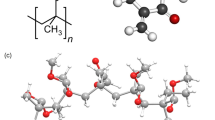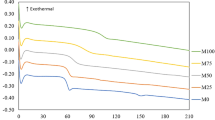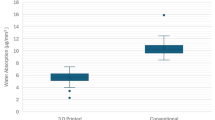Abstract
IN view of the use of polymethyl methacrylate (PMMA) for the production of surgical and dental prostheses, its properties at body temperature and those encountered in the mouth are of particular importance. Furthermore, the necessity for the incorporation of metal inserts and porcelain teeth makes its thermal properties of unusual interest. The thermal expansion of both commercial PMMA (‘Perspex’) and samples prepared by dental techniques was examined by means of a specially constructed dilatometer. Increase in length was recorded by means of a dial gauge reading to 0.0005 mm, and temperatures were measured at three points along 70 mm specimens by means of a Leeds and Northrup potentiometer. Specimens were arranged in a silica vessel which in later experiments was filled with water to determine the effect of water absorption on the thermal properties of PMMA. Increase in length was plotted against rise in temperature between 20° and 40° C. The resulting graphs showed a change in upward slope between 30°–32° C. The thermal properties were studied daily for periods up to 35 days with the specimens immersed in water and for similar periods with the same specimen drying out. Graphs prepared as before showed no alteration in the position at which an upward change in slope occurred, although the thermal expansion was greater for saturated specimens than for dry ones. Several second-order phase transition points have been recorded1 for PMMA, but so far as we can ascertain, no reference to one in the temperature range of 30°–32° C has previously been reported.
This is a preview of subscription content, access via your institution
Access options
Subscribe to this journal
Receive 51 print issues and online access
$199.00 per year
only $3.90 per issue
Buy this article
- Purchase on SpringerLink
- Instant access to full article PDF
Prices may be subject to local taxes which are calculated during checkout
Similar content being viewed by others
References
Strella, S., J. App. Polymer Sci., 7, 569 (1963).
Author information
Authors and Affiliations
Rights and permissions
About this article
Cite this article
ATKINSON, H., GRANT, A. A Lower Transition Point for Polymethyl Methacrylate at 30°–32° C. Nature 211, 627 (1966). https://doi.org/10.1038/211627a0
Issue date:
DOI: https://doi.org/10.1038/211627a0



